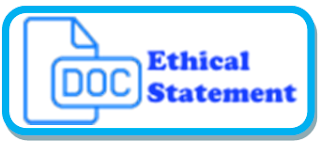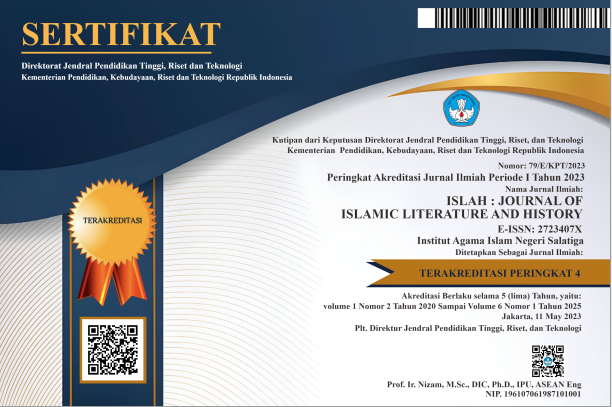Online Submissions
Already have a Username/Password for Islah: Journal of Islamic Literature and History?
Go to Login
Author Guidelines
A. AUTHOR GUIDELINES
- The paper should be submitted by the author via e-mail and online submission. The content of the article should not be submitted simultaneously to another journal.
- There is no general limitation of the overall size nor of the number of figures, nor of the level of details considered to be necessary. However, the appropriate length of a manuscript depends on the information presented in the paper. A manuscript should consist of the following content.
- The scopes of the theme are around for Islamic Literature and Islamic History, especially in the Indonesian context.
- Articles can be in the form of research results in accordance with the scope of research or in-depth study that leads to providing solutions to problems that occur in society.
- Articles length is between 6000 up to 7000 words typed by using Times New Arabic Font with 12 Font Size and 1.5 space.
- Writing articles in the form of narrative descriptions with NO Numbering System.
- The Arabic term that is not yet an Indonesian word for absorption should be transliterated by following the "TRANSLITERATION GUIDE" set forth in this writing guide based on the Joint Decree (SKB) of the Minister of Religious Affairs and the Minister of Education and Culture of the Republic of Indonesia, dated 22 January 1988, No. 158/1987 and 0543.b / U / 1987, as contained in the Guide Book of Arabic Translations ( A Guide to Arabic Transliteration ), INIS Fellow 1992. Please open the following GUIDELINES.
File articles in .doc, .docx or .rtf format uploaded by author via Open Journal System (OJS) ISLAH: http://e-journal.iainsalatiga.ac.id/islah by registering the account (register) first as author (s) and then log into the account (login) and follow the steps "VIA OJS ARTICLES DELIVERY GUIDE" next (read more CHAPTER III).
If there are obstacles in the submission of articles via OJS, please contact the admin via email with the address: journal.islah@gmail.com by including articles in .doc, .docx or RTF format.
Articles are structured as follows:
- a) Title; This is your opportunity to attract the reader’s attention. Remember that readers are the potential authors who will cite your article. Identify the main issue of the paper. Begin with the subject of the paper. The title should be accurate, unambiguous, specific, and complete. Do not contain infrequently-used abbreviations.
- b) Author(s) Name(s); Write Author(s) names without title and professional positions such as Prof, Dr, Production Manager, etc. Do not abbreviate your last/family name. Always give your First and Last Name.
- c) Affiliations; Write clear affiliation of all authors. Affiliation includes the name of department/unit, (faculty), name of university, address, country.
- d) Email Address; Write the email address with lowercase capitalization. Articles with more than one author, write only the first author's email.
- e) Abstract; Abstract should be in one paragraph between 150 sd 200 words with 1 space and written in two languages namely English with Keywords and Indonesia with Kata Kunci consisting of three to five words. The abstract should stand alone, which means that no citation in the abstract. Consider it the advertisement for your article. The abstract should tell the prospective reader what you did and highlight the key findings. Avoid using technical jargon and uncommon abbreviations. The abstract should succinctly describe your entire paper. It comprises of the purposes of the research, method, and the findings of the research. Keywords are the labels of your manuscript and critical to correct indexing and searching. Therefore, the keywords should represent the content and highlight of your article. Use only those abbreviations that are firmly established in the field. Each word/phrase in keyword should be separated by a semicolon (;), not a comma (,).
- f) Introduction; The purpose of an introduction is to justify the reasons for writing about your topic. Your goal in this section is to introduce the topic to the reader, provide an overview of previous research on the topic, and identify your own hypothesis, research, or study. If you introduce and define key words in your abstract, you need to introduce and define them in this section with Times New Arabic Font, 12 pt, and 1,5 space. All the subheadings in this section should be in Bold, Times New Arabic Font, 12pt, and 1,5 space. The first letter of each word in subheading should be in capital. Introduction consists of Background of the Study, Problems/Aims, Review of Literature or Previous Research, and Theoretical Framework (2-3 pages). From INTRODUCTION to CONCLUSION it should be 6000 – 7000 words or 18/25 pages. First Sub heading: Times New Arabic, 12, Bold, italic, justify, sentence case. Second sub heading : Times New Arabic, 12, italic, justify, sentence case
- g) Methodology; This section explains the rationale for the application of specific procedures or techniques used to identify, select, and analyze information applied to understand the research problem/project, thereby, allow the readers to critically evaluate your project’s/study's overall validity and reliability. All the subheadings in this section should be in Times New Arabic Font, 12 pt, and 1,5 space. The first letter of each word in subheading should be in capital letter. There is no methodology for non research paper. First Sub heading : Times New Arabic, 12pt, Bold, italic, justify, sentence case. Second Sub heading : Times New Arabic, 12, italic, justify, sentence case
- h) Discussions; The discussion is written to interpret and describe the significance of your findings in light of what was already known about the issues being investigated, and to explain any new understanding or insights about the problem after you have taken the findings into consideration. It should connect to the introduction by way of the research questions or hypotheses you posed and the literature you reviewed, but it does not simply repeat or rearrange the introduction; this section should always explain how your study has moved the reader's understanding of the research problem forward from where you left them at the end of the introduction. The research findings in the form of research data are further discussed or critically interpreted with particular relevant theoretical approach. Data can also be supported with the presentation of tables, images, etc. Captions for table is written above it with sequenced numbering so that it can be easily referred to, though not put under the pointing sentence/ paragraph. Line (border) to the table is made minimalist by eliminating the vertical lines and leaving horizontal lines deemed necessary. Captions for images are placed below the picture, also with providing sequenced numbering. One page only accommodates a table or an image with a maximum of two-thirds the size of the page (size adjusted as efficiently as possible). see article template
- i)Conclusions; The conclusion is intended to help the readers understand why your research should matter to them after they have finished reading the paper. It is not just a summary of the main topics covered or a re-statement of your research problem, but a synthesis of key points and, if applicable, where you recommend new areas for future research. All the subheadings in this section should be in Times New Arabic Font, 12 pt, and 1,5 space. The first letter of each word in subheading should be capital.
- j) References; The reference should be typed in Alphabetical Order, Times New Arabic Font, 12 pt, and 1,5 space with 20 references minimum requirements. It is suggested to use reference software like EndNote, Mendeley or Zotero
With format Chicago Manual of Style 17th Edition (full note)
A’La, Abd. “The genealogy of muslim radicalism in Indonesia: A study of the roots and characteristics of the padri movement.” Journal of Indonesian Islam 2, no. 2 (1 Desember 2008): 267–99. https://doi.org/10.15642/jiis.2008.2.2.267-299.
Amanollahi-Nick, Hamid, Mehdi Alipour-Hafezi, dan Darush Matlabi. “Evaluating Digital Libraries in Iranian Research Institutes: Checking against DigiQUAL Protocol.” National Studies on Librarianship and Information Organization 25, no. 3 (6 Desember 2014): 25–43. http://nastinfo.nlai.ir/article_2.html.
Garadian, Endi Aulia. “Youth Camp for Preventing Violent-Extremism: Fostering Youth Dialogue, Encountering Diversity.” Studia Islamika, 2018. https://doi.org/10.15408/sdi.v25i2.7924.
Shaikh, Mubin. “Countering Violent Extremism (CVE) Online: An Anecdotal Case Study Related to Engaging ISIS Members and Sympathizers (from North America, Western Europe, and Australia) on Twitter.” Soundings: An Interdisciplinary Journal 98, no. 4 (2015): 478–87. https://doi.org/10.5325/soundings.98.4.0478.
Submission Preparation Checklist
As part of the submission process, authors are required to check off their submission's compliance with all of the following items, and submissions may be returned to authors that do not adhere to these guidelines.
- The submission has not been previously published, nor is it before another journal for consideration (or an explanation has been provided in Comments to the Editor).
- The submission file is in OpenOffice, Microsoft Word, RTF, or WordPerfect document file format.
- Where available, URLs for the references have been provided.
- The text is single-spaced; uses a 12-point font; employs italics, rather than underlining (except with URL addresses); and all illustrations, figures, and tables are placed within the text at the appropriate points, rather than at the end.
- The text adheres to the stylistic and bibliographic requirements outlined in the Author Guidelines, which is found in About the Journal.
- If submitting to a peer-reviewed section of the journal, the instructions in Ensuring a Blind Review have been followed.
Copyright Notice
Copyright
Authors retain copyright and grant the journal right of first publication with the work simultaneously licensed under a Creative Commons Attribution-ShareAlike 4.0 International License. In line with the license, authors are allowed to share and adapt the material. In addition, the material must be given appropriate credit, provided with a link to the license, and indicated if changes were made. If authors remix, transform or build upon the material, authors must distribute their contributions under the same license as the original.
Licensing

This work is licensed under a
Creative Commons Attribution-ShareAlike 4.0 International License.
Privacy Statement
The names and email addresses entered in this journal site will be used exclusively for the stated purposes of this journal and will not be made available for any other purpose or to any other party.














